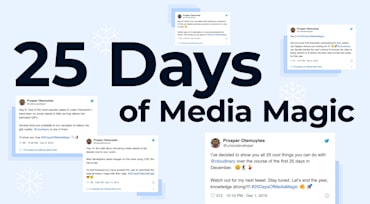A standard invented in the 1990s by Netscape, secure HTTP (HTTPS) safeguards and encrypts web content by combining two protocols: HTTP (for communications) and Transport Layer Security (TLS) (for encryption). Since then, that standard has been widely adopted for e-commerce and banking sites. According to HTTP Archive, despite its cost, complexity, and slower performance, HTTPS has been gaining popularity since 2015, with the number of related sites rising by over 70 percent that year—an increase from 14 to 24 percent of all sites.

If you're the developer for an online store, a news site, a social media app, or any other website that delivers new media content on a regular basis, you are probably painfully familiar with both the challenge and importance of delivering well-cropped images.

Want to learn how to win audiences with video? At 1:00 p.m. ET on Tuesday, February 25, Cloudinary will join Playmaker, Bleacher Report’s in-house creative agency, for an Adweek webinar on improving user engagement through video. Beckley Mason, executive director of Playmaker, and Sanjay Sarathy, Cloudinary’s VP of marketing, will offer proven, real-world tips for creating and delivering dynamic, compelling video experiences to online audiences worldwide.

Since 1999, WebRTC has served as an open-source and free solution for real-time audio and video communications within webpages, eliminating the need to use plugins, native apps, or other third-party software. I first became aware of WebRTC when Google and other browser vendors started supporting it. Many products, including Amazon Chime and Slack, have since jumped on the bandwagon.

I’m a developer turned instructional designer. In fact, I’ve been coding professionally since graduate school in the mid-1980s and have worked through many iterations of delivering apps to users over the decades. It just keeps getting to be more and more fun!


To me, one of the most exciting aspects in a company’s lifecycle in which to participate is the product roadmap. As a customer of numerous services and from my many years of working in Customer Success, visibility into a company’s product plans reinforces my trust in it and my affinity for the brand. The fact that I’m entrusted with those plans, invited to provide feedback, and actually steer the company’s direction means the world to me. I feel that not only am I being heard, but that I’m also afforded the opportunity to make a difference.

Happy New Year, folks!
As a relentless technology advocate and a developer who’s worked on media transformation for numerous projects over the years, I decided in late 2019 to go on a 25-day journey of sharing my learnings on Twitter. The aim was to show my audience the options available for them to do magic with any type of media file and spark ideas that would take maximum advantage of those techniques in their future projects.

Even though the image format animated GIFs are gaining popularity, their file size is usually large, causing slow loading and incurring high bandwidth costs. Besides, the GIF format is old and not optimized for modern video clips. The developer’s job of effecting fast loading of animated GIFs and delivering optimized images is complex and time-consuming.

Wouldn’t it be cool to have the powers of Gatsby rendering performant pages and serving optimized and transformed media files from Cloudinary on the same site? That’s now a reality: I’m excited to introduce two Gatsby plugins on Cloudinary: Gatsby-Source-Cloudinary and Gatsby-Transformer-Cloudinary.
